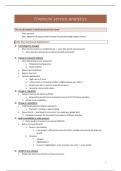Samenvatting
Volledige samenvatting Financial service analytics
- Instelling
- Universiteit Gent (UGent)
Dit is een samenvatting voor financial service analytics in de opleiding handelswetenschappen (afstudeerrichting: finance en risicomanagement). De kwaliteit van de samenvatting valt niet te betwisten, door enkel dit te leren behaalde ik een 18/20 voor het vak. Duidelijke structuur.
[Meer zien]



